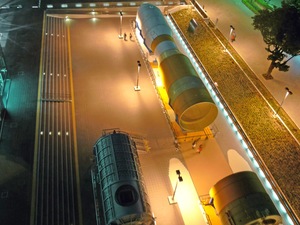Nagoya City Science Museum
TOP > Exhibition Guide > Floor Map> Environmental-friendly lights for light pollution
Environmental-friendly lights for light pollution



Purpose of Exhibition
Even if the weather is fine at night, you can see only a few stars in the sky if you are in a city. This is not because of polluted air in such places, but because the night sky is lit up by outdoor lighting, including street illumination. The artificial brightness of the sky overpowers faint stars, thereby obstructing our view of the night sky. When nighttime illumination has adverse effects on the landscape or environment of the surrounding areas, it is called “light pollution.” The establishment of an appropriate lighting environment would make it possible to view many more stars at night.
The Nagoya City Science Museum has installed park lighting equipment to reduce light pollution. Related exhibits are also on display in “Our Universe” on the fifth floor of the Astronomy Building.
Additional Knowledge
[History of Light Pollution Control Measures]
Light pollution control measures aim to create a desirable lighting environment while accomplishing the intended purpose of installing lighting equipment. Lighting up a park at night is designed to provide a safe and secure environment for visitors. At the same time, efforts have been made to prevent light from being reflected upwards and to reduce electricity consumption. Consequently, artificial brightness of the sky is reduced, making stars more visible.
In the 1980s, the Nagoya City Science Museum launched research on what to do to enjoy the starry sky in cities, and proved that the visibility of stars at night had been reduced by outdoor illumination, rather than air pollution. Based on these research results, Nagoya City worked with the then Environment Agency to take light pollution control measures in order to reduce energy consumption and improve the visibility of stars, which eventually led to the development of the light pollution control guidelines in 1998.
As part of the model project to promote light pollution control measures of the then Environment Agency, we also developed park lighting equipment that can reduce light pollution, and installed it together with an exhibit panel around our museum. In 2011 when the Science Museum was renovated, the park lighting equipment was replaced by a new-generation park lighting system, which is currently on display. The project to develop light pollution control guidelines involved lighting equipment manufacturers. Participating manufacturers made proactive efforts, which were reflected in the preparation of catalogs that feature light pollution control-conscious lighting apparatuses, supported by numerical information.
Once again, we needed to newly develop park lighting equipment in order to achieve the intended performance. This time, however, we were able to select lighting equipment meeting our project standards from among ready-made products. This means that light pollution control measures have been promoted effectively. If you have a chance to change outdoor lighting, you are encouraged to choose an illumination system designed to reduce light pollution, which will eventually contribute to saving energy and improving the visibility of stars in the night sky.
